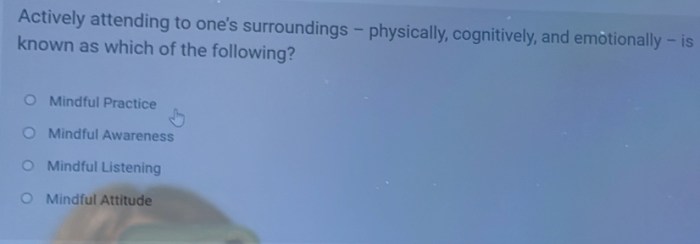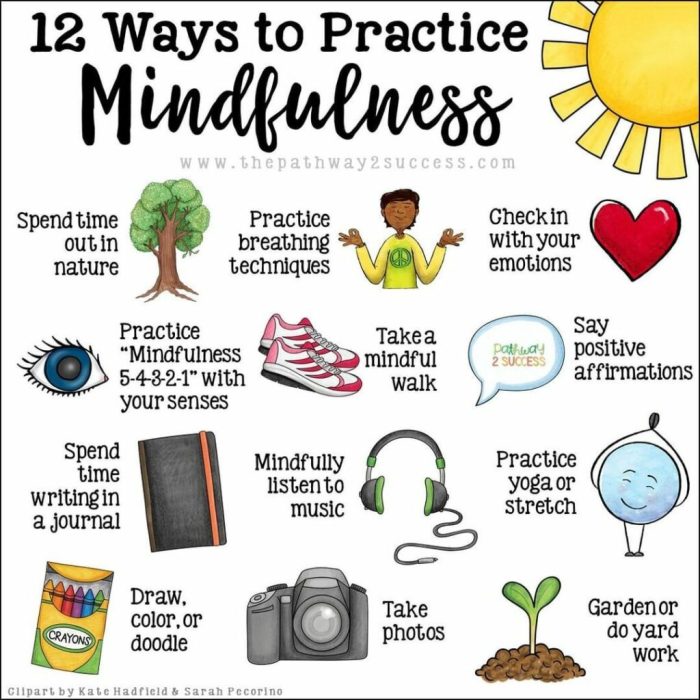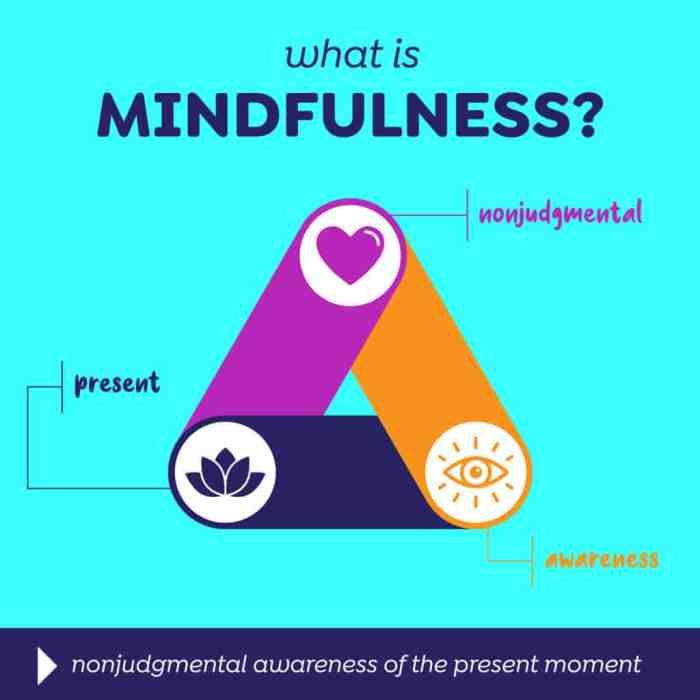10 Techniques to Build Mindful Awareness sets the stage for this enthralling narrative, offering readers a glimpse into a story that is rich in detail and brimming with originality from the outset. The exploration of various techniques, breathing exercises, body scan meditation, and mindful eating practices will provide a comprehensive guide to enhancing mindfulness in everyday life.
Techniques for Mindful Awareness

In today’s fast-paced world, cultivating mindfulness is essential for mental well-being. Here are 10 techniques that can help build mindful awareness and promote a sense of calm and clarity in daily life.
1. Mindful Breathing
Practicing mindful breathing involves focusing on the sensation of your breath as it enters and leaves your body. This technique helps anchor your awareness to the present moment, reducing stress and promoting relaxation.
2. Body Scan Meditation
Body scan meditation involves mentally scanning your body from head to toe, paying attention to any areas of tension or discomfort. This technique helps cultivate body awareness and promotes relaxation.
3. Mindful Eating
Mindful eating involves paying full attention to the experience of eating, focusing on the taste, texture, and sensation of each bite. This technique can help develop a healthier relationship with food and prevent overeating.
4. Walking Meditation
Walking meditation involves walking slowly and mindfully, paying attention to each step and the movement of your body. This technique can help ground you in the present moment and increase awareness of your surroundings.
5. Loving-Kindness Meditation
Loving-kindness meditation involves sending positive thoughts and wishes to yourself and others. This technique can help cultivate compassion, empathy, and goodwill towards yourself and those around you.
6. Mindful Journaling
Mindful journaling involves writing down your thoughts and feelings without judgment, allowing you to reflect on your experiences with mindfulness and self-awareness. This technique can help clarify your thoughts and emotions.
7. Progressive Muscle Relaxation
Progressive muscle relaxation involves tensing and releasing each muscle group in your body, promoting physical relaxation and reducing tension. This technique can help increase body awareness and reduce stress.
8. Mindful Listening
Mindful listening involves giving your full attention to the speaker without interrupting or formulating a response. This technique can help improve communication skills and deepen your connection with others.
9. Gratitude Practice, 10 Techniques to Build Mindful Awareness
Gratitude practice involves reflecting on the things you are thankful for in your life, fostering a sense of appreciation and contentment. This technique can help shift your focus from negativity to positivity.
10. Mindful Technology Use
Mindful technology use involves being intentional and present while using electronic devices, setting boundaries to avoid distractions and promote digital well-being. This technique can help reduce stress and improve focus.
Mindful Breathing Exercises: 10 Techniques To Build Mindful Awareness

Breathing exercises are an essential part of mindfulness practices, helping individuals cultivate awareness and presence in the moment. These exercises can have profound physiological and psychological benefits, promoting relaxation, reducing stress, and improving overall well-being. Here, we will explore various mindful breathing techniques and their impact on mindfulness journeys.
Diaphragmatic Breathing
Diaphragmatic breathing, also known as belly breathing, involves taking deep breaths to fully engage the diaphragm. To perform this exercise:
- Sit or lie down in a comfortable position.
- Place one hand on your chest and the other on your abdomen.
- Inhale deeply through your nose, allowing your abdomen to rise as you fill your lungs with air.
- Exhale slowly through your mouth, feeling your abdomen fall as you release the breath.
- Repeat this process for several minutes, focusing on the sensation of your breath moving in and out of your body.
Box Breathing
Box breathing is a technique that involves inhaling, holding the breath, exhaling, and holding the breath again in a rhythmic pattern. To practice box breathing:
- Sit in a quiet place with your back straight.
- Inhale deeply for a count of four seconds, filling your lungs completely.
- Hold your breath for another four seconds.
- Exhale slowly for four seconds, letting out all the air from your lungs.
- Hold your breath again for four seconds before repeating the cycle.
Mindful Counting
Mindful counting is a simple yet effective breathing exercise that involves counting each breath to maintain focus and awareness. To try mindful counting:
- Sit or stand comfortably with your eyes closed.
- Inhale deeply and slowly while silently counting “one” in your mind.
- Exhale slowly and completely, counting “two” with each breath out.
- Continue this pattern, counting up to ten breaths and then starting over from one.
- Focus on the sensation of your breath and the counting to stay present in the moment.
Personal Testimonials
Individuals who have incorporated mindful breathing exercises into their daily routines have reported significant improvements in their mindfulness practices. Many have experienced reduced anxiety, increased focus, and a greater sense of calmness and clarity. By regularly practicing mindful breathing, individuals have been able to cultivate a deeper connection to the present moment and enhance their overall well-being.
Body Scan Meditation

Body scan meditation is a mindfulness practice that involves focusing on different parts of the body, systematically moving attention from one area to another. This technique helps in building mindful awareness by increasing the connection between the mind and body, promoting relaxation, and reducing stress.
The Process of Body Scan Meditation
During a body scan meditation session, practitioners often start by lying down in a comfortable position. They then bring their awareness to each part of the body, starting from the toes and moving upwards towards the head. As attention shifts from one body part to another, individuals observe any sensations, tension, or discomfort without judgment, allowing them to release any physical or emotional blockages.
Benefits of Body Scan Meditation
- Enhances Mindfulness: By focusing on the body, practitioners cultivate present moment awareness and develop a deeper connection to physical sensations.
- Stress Reduction: Body scan meditation helps in releasing tension and promoting relaxation, leading to reduced stress levels and improved overall well-being.
- Improved Body Awareness: Regular practice of body scan meditation enhances body awareness, making individuals more attuned to their physical needs and sensations.
- Emotional Regulation: By observing physical sensations without judgment, practitioners learn to process emotions more effectively and develop emotional resilience.
Tips for Enhancing Body Scan Meditation
- Set aside dedicated time for practice to ensure a quiet and uninterrupted session.
- Use guided body scan meditations or soothing music to enhance the experience.
- Experiment with variations such as incorporating deep breathing or progressive muscle relaxation techniques.
- Practice self-compassion and patience during the session, allowing yourself to fully experience each sensation.
Mindful Eating Practices

Mindful eating is a practice that involves paying full attention to the experience of eating and drinking, both inside and outside the body. It helps us become more aware of our thoughts, feelings, and physical sensations related to eating, leading to a healthier relationship with food.
Guidelines for Mindful Eating
- Avoid distractions: Turn off the TV, put away your phone, and focus solely on the act of eating.
- Use all your senses: Notice the colors, smells, textures, and flavors of your food.
- Eat slowly: Take small bites, chew thoroughly, and savor each mouthful.
- Pay attention to hunger and fullness cues: Stop eating when you feel satisfied, not when your plate is empty.
- Express gratitude: Acknowledge the effort that went into preparing your meal and be thankful for the nourishment.
Mindful Eating and Well-being
Practicing mindful eating has been linked to various benefits for overall well-being. By being more present during meals, individuals tend to make healthier food choices, experience improved digestion, and develop a deeper appreciation for the food they consume. This can lead to better weight management, reduced stress levels, and a more positive relationship with eating habits.
Personal Anecdotes
One individual shared how incorporating mindful eating practices helped them overcome emotional eating patterns. By being more mindful of their triggers and responses to food, they were able to make conscious choices that supported their well-being. Another person mentioned how practicing gratitude during meals shifted their perspective on food from one of guilt to one of nourishment and pleasure.
Epilogue

In conclusion, the journey of building mindful awareness through these techniques is a transformative experience that can lead to a deeper sense of presence and well-being. By incorporating these practices into daily life, individuals can cultivate a greater sense of mindfulness and awareness in all aspects of their lives.